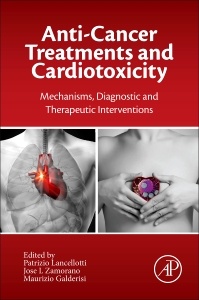Description
Anticancer Treatments and Cardiotoxicity
Mechanisms, Diagnostic and Therapeutic Interventions
Coordinators: Lancellotti Patrizio, Zamorano Jose L, Galderisi Maurizio
Language: English
Subjects for Anticancer Treatments and Cardiotoxicity:
Keywords
<; P>; cardiotoxicity; anti-cancer treatments; heart; toxicology; radiotherapy; cardiac dysfunction<; /P>
470 p. · 15x22.8 cm · Hardback
Description
/li>Contents
/li>Biography
/li>Comment
/li>
Anticancer Treatments and Cardiotoxicity: Mechanisms, Diagnostic and Therapeutic Interventions presents cutting edge research on the adverse cardiac effects of both radiotherapy and chemotherapy, brought together by leaders in the field. Cancer treatment-related cardiotoxicity is the leading cause of treatment-associated mortality in cancer survivors and is one of the most common post-treatment issues among survivors of adult cancer. Early detection of the patients prone to developing cardiotoxicity, taking in to account the type of treatment, history and other risk factors, is essential in the fight to decrease cardiotoxic mortality.
This illustrated reference describes the most effective diagnostic and imaging tools to evaluate and predict the development of cardiac dysfunction for those patients undergoing cancer treatment. In addition, new guidelines on imaging for the screening and monitoring of these patients are also presented. Anticancer Treatments and Cardiotoxicity is an essential reference for those involved in the research and treatment of cardiovascular toxicity.
Section I: General Considerations 1. Epidemiology and Trend of Prognosis in Cancer Patients 2. Categories of Anticancer Treatments 3. Classification by Mechanisms of Cardiotoxicity 4. Cardiotoxicity of Oncologic Treatments: Is There a Uniform Definition? 5. The Impact of Radiotherapy
Section II: Detrimental Effects of Anticancer Drugs and Radiotherapy on the Heart 6. Lessons From Preclinical Models 7. Genetic and Epigenetic Risk Factors 8. Changes of Myocardial Structure and Function 9. Alteration of Heart Valves 10. Pericardial Damage 11. Effects of Radiotherapy on Vessels and Coronary Arteries 12. Cardiac Conduction Disturbances
Section III: Cardiovascular Complications of Cancer Treatments 13. Cardiac Rhythm Disturbances 14. Acute and Chronic Heart Failure 15. Coronary Artery Disease 16. Pericardial Effusion and Pericarditis 17. Radiation-Induced Carotid Atherosclerosis 18. Valvular Heart Disease 19. Atrial Fibrillation and Stroke in Cancer Patients
Section IV: Imaging Evaluation of Cardiac Structure and Function in Cancer Patients 20. The Role of Echocardiography 21. The Role of Cardiovascular Magnetic Resonance (CMR) 22. Nuclear Medicine Imaging and Cardiotoxicity
Section V: Detection of Cardiac Dysfunction and Predictors of Cardiotoxicity 23. Detection by Cardiac Imaging: LV Ejection Fraction, Diastolic Dysfunction, Tissue Doppler, and Speckle Tracking Echocardiography 24. The Role of Biomarkers: Troponins, BNP, MPO, and Other Biomarkers 25. Screening and Comprehensive Follow-Up Evaluation 26. Preoperative Assessment for Noncardiac Surgery
Section VI: Cardiotoxicity in Childhood 27. Cardiotoxicity of Childhood Cancer Treatments
Section VII: Management of Anticancer Drugs Related Cardiotoxicity 28. Nonpharmacologic Therapy 29. Beta-Blockers 30. Angiotensin-Converting Enzyme Inhibition 31. Diuretics 32. Antiarrhythmic Drugs 33. Anticoagulation in Cancer Patients 34. New Drugs: The Beneficial Effects of Ranolazine 35. Percutaneous Coronary Intervention and Cardiac Surgery in Cancer Patients 36. Focus on the Patient With Known Cardiac Disease 37. Multidisciplinary Approach to Cardiac Disease in Cancer Patients
Section VIII: Future Research Priorities 38. Pharmacogenomics Screening 39. Cardiac Monitoring During Clinical Trials 40. Preventive Therapy 41. Cardiotoxicity: Future Research Directions
José Luis Zamorano is Professor of Medicine and Head of Cardiology at the University Complutense in Madrid and Director of the Cardiovascular Institute at the University Clinic San Carlos, Madrid. His key research interests include ischemic heart disease, cardiovascular risk factors and imaging modalities. Professor Zamorano is President Elect of the European Association of Echocardiography (EAE) and President of the Working Group on Non-invasive Diagnostic Imaging of the Spanish Society of Cardiology. He serves on numerous Editorial Boards, including the European Journal of Echocardiography, the American Society of Echocardiography and the European Heart Journal. He has authored over 400 articles for peer-reviewed journals and has an H-index = 57.
Maurizio Galderisi, is Associate Professor of Cardiology and Clinical Director at Federico II University Hospital in Italy. His research interests include cardiac function, heart failure, arterial hypertension, tissue Doppler and strain rate imaging, coronary flow reserve. He has served as editor of one book and author of 10 chapters in various cardiologic books. He is the author or co-author of 250 articles on international peer-reviewed indexed journals, with an H-index = 38. He has been an invited speaker at more than 70 major national and international meetings and holds scientific association membership with Società Italiana di Cardiologia (SIC), Società Italiana di Ecografia Cardiovascolare (SIEC), European Association of Echo
- Provides algorithms essential for the use of imaging, and biomarkers for the screening and monitoring of patients
- Written by world-leading experts in the field of cardiotoxicity
- Includes high-quality images, case studies, and test questions
- Describes the most effective diagnostic and imaging tools to evaluate and predict the development of cardiac dysfunction for those patients undergoing cancer treatment




